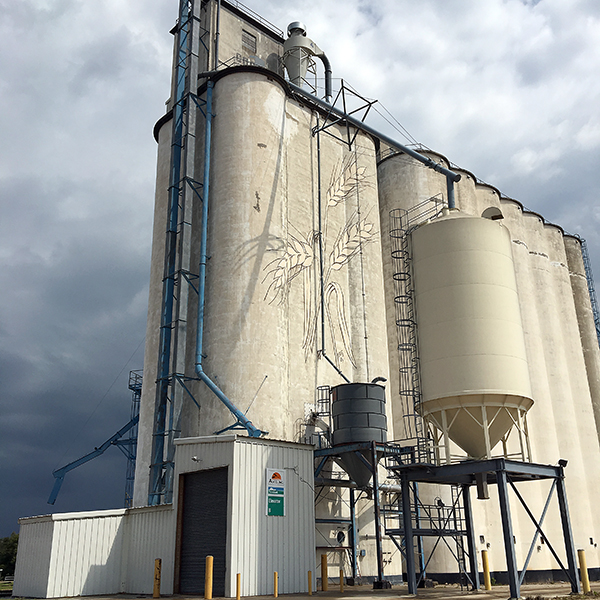Knowing When to Get Off
By DAVE BERRY
I have only bailed out early on one job in my life.
It was the summer of '69 and I grabbed a job that sounded great on paper - bridge construction. I would have to go a long way to find a job in Russell County, Kansas, that paid that well.
But after my first day, I knew I had made a mistake. It was 110 in the shade, and we were a long way from shade. Calf-deep in concrete, I was assigned to stand amid the rebar mesh, awaiting the arrival of the next bucket of slurry being hoisted by a clanking truck-mounted crane onto the half-built span.
If the operator stopped the heavy bucket's swing at the right spot, I grabbed the handle and dumped the load. If he didn't, it either knocked me over or broke my legs. I left after one day with both legs intact.

I enlisted the next day at one of the grain elevators along the railroad tracks just north of downtown. All three were staffing up for the Kansas wheat harvest.
I was to be a grain handler. Armed with a scoop shovel, I would wave the overloaded wheat trucks one by one through the elevator door, stopping them over a grate covering the open pit below.
Opening the metal doors of the end-gate sent sheets of wheat pouring out and down into the pit, there to be scooped up by clattering augurs that sent the grain upward to the very top of the elevator. High above, the wheat spilled down again into concrete silos, where it was stored.
Trucks without hydraulic lifts were hoisted by their front wheels until their cabs were suspended high off the ground. As their loads shifted to the back, we climbed onto the tilted beds and - with metal shovels screeching across wooden decks - scooped grain out of the corners, finishing the job. As one empty truck exited, another was waved in.
During slack times, the boss would grab my shovel and hand me a broom. Then, with a few words of instruction, he would send me to the top of the tower where deep layers of dust awaited.
The elevator to the top floors was an old-fashioned "manlift," basically a thick rubber strap that looped continuously from the bottom to the top of the elevator. Since the top floor was about 12 stories or almost 100 feet up, the manlift strap was essentially a 200-foot-long rubber band.
Attached to the strap every 10 feet or so were hard rubber steps. Midway between each step was a rubber handle.
To ride it, you had to be decisive. As a handle came up through the hole in the floor, you grabbed it. Then, as the step appeared, you hopped on and headed up. Stand straight and hold tight against the strap and you would fit comfortably through the man-sized holes in each floor above. Anything else and you might scrape the sides or get knocked off.
To go up one floor, you waited until you were completely through the open hatchway, then stepped off onto the floor as your feet cleared. The belt didn't stop but kept moving in a continuous loop.
To go higher, you stayed on the strap, watching for the numbers painted prominently on each floor. If you were going to the top, you watched for the number of that floor and stepped off at the proper time. I don't remember now how many actual floors there were, but I know you did not want to miss the last one. Once at the top, you got off.
Getting there was no more dangerous than being there. Up top, you swept up buckets of explosive wheat dust, trying not to breathe too much in. And you generally wanted to avoid the area over the concrete silos. The walkway across the top was a series of two-by-twelve boards, and it was a long way down.
Going down, you mounted the manlift on the opposite side, this time standing on what had been the underside of the step coming up. On your first trip back down, you were allowed to think about it a bit before jumping on. After all, you were stepping on and grabbing a handle just as it dropped away through the open door 100 feet above the ground.
But you couldn't get too attached to that handle. When you got to the ground floor, you had to get off.
Riding the manlift was not a passive experience, like riding a modern elevator. The strap kept going, and if you held on too long at the top, it would take you up and over. I never wanted to experience that. And at the bottom, I'm sure the experience would have been just as troublesome.
While the job at the grain elevator was certainly more dangerous than my short hitch on the bridge-building crew, I stayed almost two months, through the entire harvest, leaving when the trucks stopped rolling in and the work played out.
That day on the bridge, serving as a target for the crane operator and his bucket of concrete slurry, I knew for sure I needed to leave.
I guess it was like riding that manlift to the top of the elevator; the secret was knowing when to get off.
Dave Berry is the retired editor of the Tyler Morning Telegraph. This Focal Point column was published March 2, 2014.
Photo: Hundreds of these "sentinels of the plains" tower over the flat Kansas skyline.(Photo by Dave Berry)
